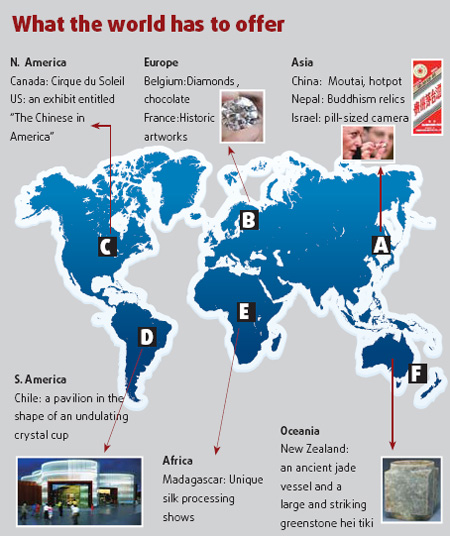
Chongqing: Hot and cold
Chongqing is bringing its famous hotpot, noted for its spicy taste, to the Shanghai Expo.
People in the municipality in southwestern China have been eating lamb and beef boiled in chili-laden soup for centuries - it was first eaten by boatmen working along the Yangtze River about 1,000 years ago.
The pavilion will include a virtual hotpot, allowing visitors to select their favorite dishes from a touch-screen menu. The dishes will then be poured into the hotpot automatically, accompanied by animated special effects.
Other treats at the Chongqing pavilion include relics from White Crane Ridge, which runs along the upper and middle reaches of the Yangtze River and is submerged most of the year.
The ridge, which measures about 1,600 m by 10 m, has been described by UNESCO as "the only well-preserved ancient hydrological station in the world". Its engravings of fish and text helped establish high and low water marks of the Yangtze.
The pavilion will exhibit a duplicate of inscribed stone from the ridge, the original of which can be observed in an underwater museum that was built in Chongqing last year.
Guizhou: Reputation 'karst' in stone
Ever since former Chinese premier Zhou Enlai treated his state-banquet guests to a bottle of Moutai, a clear Chinese liquor made from fermented sorghum, it has earned its place as the country's tipple of choice.
Guizhou proudly calls itself the home of Moutai, also known as baijiu, a drink with an especially strong kick given its alcohol content of up to 53 percent. It is said to take its soy-sauce-like fragrance from the unique conditions found in the city of Renhuai in this southwestern province.
Moutai won international recognition at the 1915 World Expo in San Francisco, where it claimed gold in the competition to find the event's top liquor.
The good news for the first 100 visitors to the Guizhou pavilion each day is that they will be given a free cup, with a bottle reserved for every 1,000th guest.
In fact, water seems to be one of the pavilion's over-arching themes, with visitors encountering a miniature version of Huangguoshu Waterfall, the biggest waterfall in China, once they step inside.
South China features a diverse karst landscape and has been described as a museum of continental karst formations. The special nature of the stone gives Guizhou its fascinating natural scenery. The Dragon's Palace is a splendid example of an underground karst cave that looks like a palace made of crystal. It will be represented on a much smaller scale inside the pavilion.

